[Economic Significance] Coleoptera is commonly known as beetles. The forewings are cutinized into elytra, and the body is hard. The armor-like body wall protects the insect body, allowing them to resist various harms in nature. Their exquisite body structure and wide adaptability help them successfully occupy various habitats on land, in the air and in the water, making them the largest order in the class Insecta. Some of these species are important pests and beneficial insects in agriculture, forestry, fruit trees and horticulture, or have become worldwide pests in various types of warehouses and human homes due to commercial transportation and other reasons.
[Identification points] The compound eyes are well developed and there is often no single eye. The shape of the antennae is variable. Chewing mouthparts. Forewings elytra, hindwings membranous, sometimes vestigial. When resting, the elytra are placed on the back of the chest and abdomen, covering the hind wings.
The characteristics of this order can be summarized as follows: Coleoptera with armored body, variable antennae and no eyes; developed small scutes on the chest, and larvae with few or no legs.
[Species and Distribution] There are 350,000 known species of Coleoptera, which is the largest order in the animal kingdom, accounting for more than 40% of the Insecta species, and is widely distributed around the world. About 10,000 species have been recorded in my country.
[Classification system and introduction to important families] Coleoptera is divided into 2-5 suborders. The polyphagous suborder and the carnivorous suborder are the two basic suborders, and the other suborders are separated from them. Now we introduce some important pests or common families. For ornamental beetles, please refer to "Part 5: Strange Beetles".
I. Carnivorous suborder Adephaga
There is a dorsal suture on the prothorax; the base of the hind foot is fixed on the abdominal plate of the posterior thorax and cannot move, and completely separates the first abdominal plate. The pronotum and side plates are clearly separated. Tarsi 5-5-5. The tentacles are mostly filamentous. Most species are predatory, and only a few are herbivorous.

(1) Cicindelidae
Medium size, long cylindrical shape, with metallic luster and bright markings. The mouth is under the head, slightly wider than the chest. Antennae spacing less than width of upper lip.
Adults of most species are very active. They like to forage for small insects in fields and rivers during the day and move quickly. Wingless individuals are often active at night. The larvae live in caves in sandy grasslands and prey on prey close to the entrance of the cave. There are barbs on the back of the abdomen to prevent the prey from struggling to escape the larvae from the cave. There are about 2,000 known species in the world, and there are more than 100 species in my country. Common ones include Cicindela chinensis De Geer, etc.
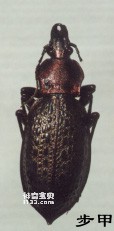
(2) Carabidaae
The body is small to large, black, brown and shiny. The head is smaller than the chest, with an anterior mouth. The compound eyes are large, the antennae have 11 segments, and the distance between the antennae is greater than the width of the upper lip.
Adults and larvae live in surface soil, on the ground or in ant nests, or on plants, and can prey on insects, spiders or molluscs. Some species are herbivorous and can harm cereals, strawberries, potatoes, or feed on fungi, humus, etc. Most adults have phototaxis, and their gluteal glands can release defensive substances such as formic acid or benzoquinone. There are about 25,000 known species in the world, and more than 1,700 species have been recorded in my country. Common ones include Calosoma chinense Kirby and others.
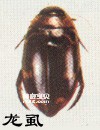
(3) Dytiscidae
Small to large, long eggs are streamlined, flat and smooth. The head is retracted into the chest. The hindfoot is a swimming foot, and the posterior basal segment and posterior thorax and abdomen occupy more than half of the ventral surface.
Both adults and larvae live in still or running water, and a few are found in brine or hot springs. They can prey on molluscs, insects, tadpoles or small fish. The larvae are particularly voracious. Adult worms are phototaxis, and their gluteal glands can release benzoic acid and steroid substances that are significantly toxic to fish and other aquatic vertebrates, and can harm rice and wheat seedlings. There are about 4,000 known species in the world, and about 200 species have been recorded in my country. Common ones include Cybister japonicus Sharp, etc.
II. Polyphaga
The abdominal plate of the first segment of the abdomen is not divided by the base of the hind foot, the base of the hind foot is not fixed on the abdominal plate of the posterior thorax, and there is no obvious boundary between the pronotum and lateral plate. The head is not beak-shaped, and the external pharyngeal slit is clearly separated.
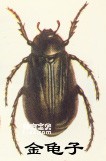
(1) Scarabaeoidea
The 3-7 segments at the end of the antennae are comb-toothed or gill-shaped. The feet are often suitable for digging. It includes more than 20 families, and the common ones are Dung Beetles, Branchial Beetles, Orchididae, Anthropodidae, Rhinocerosidae (Rhinocerosidae), Stag Beetles, etc.
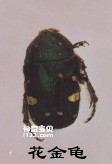
A. Cetoniidae
The body is flat and wide, and the body color is beautiful. The upper lip is degenerated or membranous. The outer edge of the elytra is concave, and there is a round forward protrusion on the midthorax and abdomen. Adult insects are active during the day, often burrowing into flowers to feed on pollen and nectar, and chewing petals and ovaries, so they are known as "flower lurkers." Common ones include white star beetles, Liocola brevitarsus Lewis, etc.
B. Rutelidae
The body color is blue, green, brown, yellow, red, etc., with metallic luster. The claws of the feet are asymmetrical, especially the hind claws. The elytra often have membranous margins. It is polyphagous and often harms forests and fruit trees. Common ones include Anomala corpulenta Motsch., etc.

(2) Chrysomelidae
Small to medium size, oval, convex back, bright color or metallic luster. The head is sub-anterior, with obvious anterior lip base. The compound eyes are in contact with the front edge of the prothorax, and the pronotum has lateral edges. The forefoot base is transverse. Both adults and larvae are herbivorous. There are 2,600 known species in the world, and 1,200 species have been recorded in my country.

(3) Flea beetle family Halticidae
The leg joints of the hind feet are enlarged and are good at jumping. There are often grooves on the outside of the tibia joints.
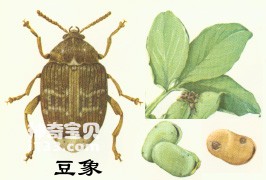
(4) Bruchidae
The body is small and oval. The forehead is extended into a short beak shape; the compound eyes are extremely large. The antennae are serrated, comb-shaped or club-shaped, and can be distinguished from weevils with geniculate antennae. The elytra are short and the end of the abdomen is exposed. Adult insects have the habit of visiting flowers. Insects of this family harm leguminous plants, and their larvae feed on the seeds. The broad bean weevil, Laria rufimanus Boheman, is a major pest that harms broad beans and is listed as a quarantine target.
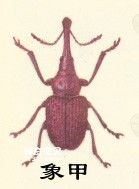
III. Rhynchophora
The head extends into a beak-like or trunk-like shape, and the external pharyngeal suture heals into one or disappears. The front chest is cylindrical and has no seams. Herbivorous.
(1) Curculionidae
The head of the adult insect extends into a beak-like or trunk-like shape. The antennae are knee-shaped, and the ends are enlarged into hammer-like shapes. The largest family in Coleoptera, with 60,000 species known in the world.
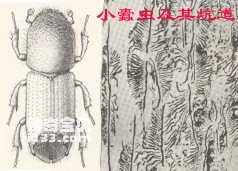
(2) Scolytidae
Small, cylindrical, brown or dark brown. The head has no beak, and the back of the head is covered by the pronotum. Head narrower than pronotum. There are teeth on the outer edge of the anterior tibia, and there is a strong distal tip on the outer end. The first tarsal segment is obviously shorter than the rest of the segments combined.
When the female insect replenishes nutrients, it bites off the cortex of the young shoots of the tree, or burrows into the bark to form tunnels. The larvae feed on sap, fungi, or wood borers, and the pattern of the borers varies from species to species. Small beetles are often secondary forest pests and can sometimes cause the death of large areas of young or adult forests. There are about 3,000 species in the world, and about 500 species have been recorded in my country. Common ones include fruit tree beetles, Huashan pine beetles, etc.
animal tags:
We created this article in conjunction with AI technology, then made sure it was fact-checked and edited by a Animals Top editor.